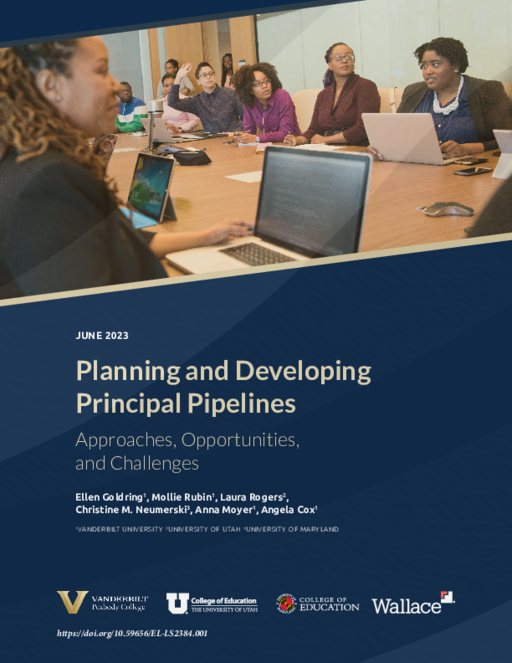- Author(s)
- Ellen Goldring, Mollie Rubin, Laura Rogers, Christine M. Neumerski, Anna Moyer, and Angela Cox
- Publisher(s)
- Vanderbilt University
Research Approach
The researchers conducted a survey of participants in the Principal Pipeline Learning Community. They also interviewed central office leaders from districts that were learning community members.
This report describes the involvement of district central office leaders who participated in The Wallace Foundation’s Principal Pipeline Learning Community (PPLC), an initiative that ran from 2019 to 2022. The PPLC brought together 84 school districts from across the country to learn about principal pipelines and approaches to planning and implementing them. The participants were from medium, large, and extra-large districts. Medium-size districts enroll 20,000 to 50,000 students, large districts enroll more than 50,000 students, and extra-large districts serve more than 100,000 students.
The report presents findings from two data sources: First, 376 central office leaders from 62 districts responded to a survey; and second, the researchers interviewed 86 central office leaders in 30 districts.
Survey
The study team sent requests to field a survey to all 84 districts participating in the PPLC. Thirteen districts declined to participate, while 9 districts did not respond to requests or other direct outreach. The final sample was comprised of 62 out of the 84 PPLC districts.
The team invited a total of 521 central office district leaders in the 62 districts to participate in an online survey from October 2021 to May 2022. The overall response rate was 72%, a total of 376 central office leaders (from the 62 districts). The number of central
office leaders participating in the PPLC varied widely from district to district. Districts independently decided who would participate in the PPLC. The researchers sent surveys to as few as 1 central office leader in a district to as many as 20 in a district, based on rosters of participation in the PPLC. The responses per district ranged from 1 to 18 respondents. The survey included questions about district leaders’ experiences with pipelines, the conceptualization and status of pipelines, the district context, and central office
organization of pipeline implementation. Because district leader participation varied
widely across the 62 districts and correspondingly, in the survey itself, the researchers applied post-stratification weights so each district is equally represented in the analysis.
Interviews
The research team interviewed central office leaders from 30 Principal Pipeline Learning Community districts engaged in principal pipeline development and planning during the 2021 school year. The research team developed a sampling frame after initial outreach to the districts to ascertain names of central office personnel active in the district’s pipeline development work or who were participating in the PPLC. Of the 30 districts with central office staff who participated in interviews, 12 districts were also interviewed during the first year of the initiative, and 18 were new to the sample in the second round of interviews.
The researchers caution that the data presented in the report most likely represent the learning community’s most engaged districts and viewpoints, that is, districts that agreed to share their insights and experiences through surveys and interviews. The team does not have data from districts that stepped away from the PPLC and pipeline work, or from districts that declined to participate in the study. The results reported are from individual central office leaders, and do not necessarily represent one, overall district
perspective.
More details on the methodology are provided in a report appendix.


